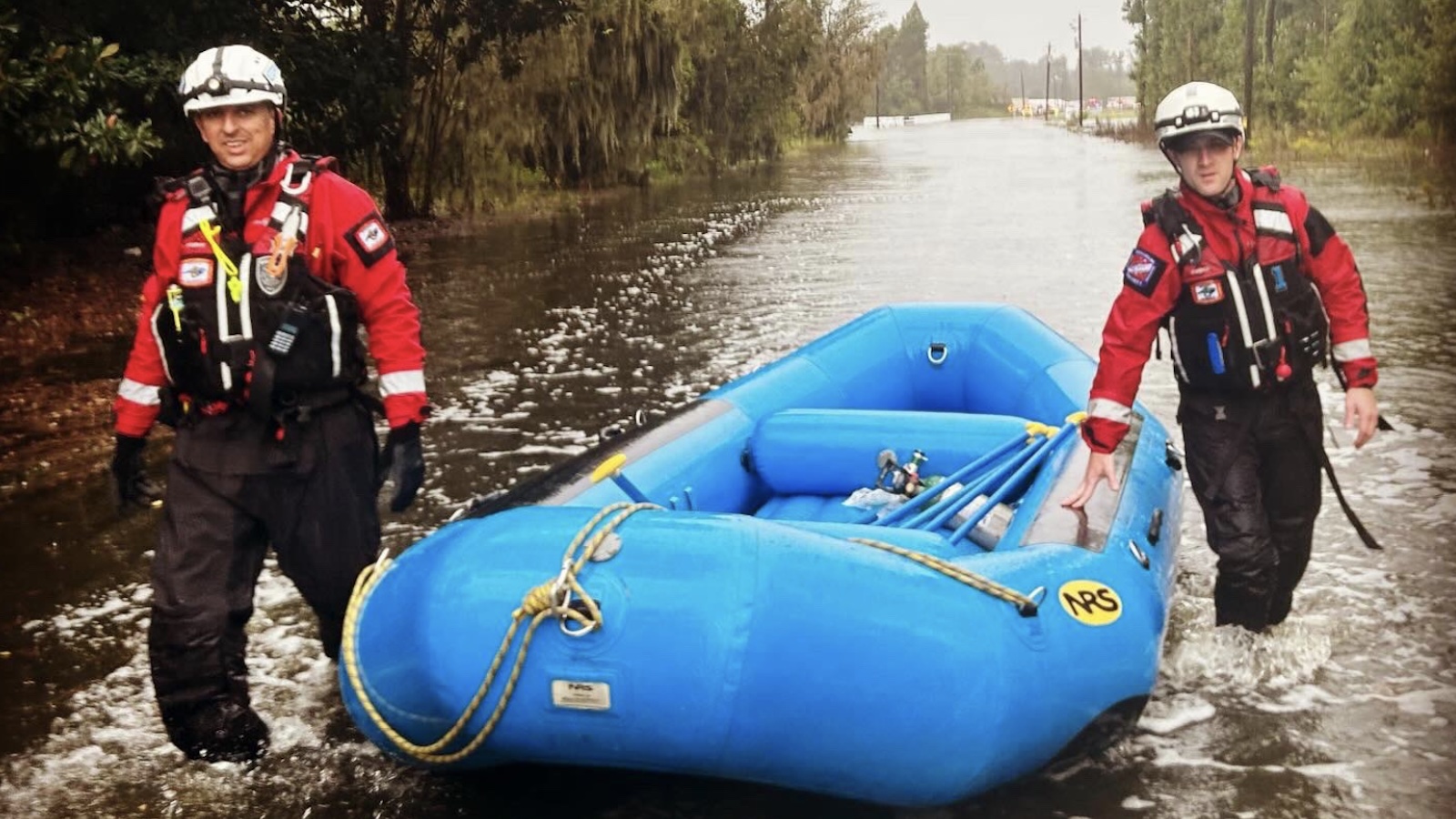Reports of neighborhood and road flooding were increasing across eastern North Carolina as Tropical Storm Ophelia moved through on Saturday afternoon, September 23. Peaking just shy of hurricane strength, Ophelia made a soggy but non-catastrophic landfall at 6:15 a.m. EDT Saturday near Emerald Isle, North Carolina, with top sustained winds of 70 mph. Sustained winds of 61 mph gusting to 73 mph were reported from Cape Lookout, North Carolina, shortly before Ophelia came ashore.
As of 2 p.m. EDT, Ophelia was centered about 60 miles southwest of Norfolk, VA, moving north at 13 mph. Top sustained winds were down to 45 mph, and these were likely limited to a small area near the center, as most nearby stations were reporting sustained winds below tropical storm strength. Ophelia’s top winds will continue to spin down as the system moves into southeastern Virginia overnight. By Sunday afternoon, as Ophelia approaches a pre-existing frontal zone to its north and is eventually shunted back offshore, it is predicted to be a depression-strength post-tropical cyclones.

Moderate to major flooding was occurring along and near the Pungo and Pamlico Rivers in North Carolina, where the surge being forced inland from Ophelia was combining with runoff from heavy rain. The Pamlico crested at 6.98 feet at Washington, the 11th highest crest there in records dating back more than 110 years. At 14th Street in Greenville, Green Mill Run rose quickly on Saturday afternoon to 10.8 feet, approaching major flood stage.
Along the coast, storm surge from Ophelia was generally coming in toward the lower end of the predicted ranges. Saturday afternoon’s high tide produced the highest storm tides of the event from Delaware to New Jersey, with mainly moderate flooding, but the tide was generally 0.5 to 1 foot lower than predicted. Below are some of the highest storm-surge values observed through Saturday afternoon, together with storm-tide amounts (storm surge plus astronomical tide, shown in values above mean low low water or MLLW). Times are in EDT.
Atlantic City, NJ: 2.43’ storm surge (7.18 a.m. Sat), 6.77’ storm tide (2:36 p.m. Sat)
Cape May, NJ: 2.7’ storm surge (8:24 a.m. Sat), 7.34’ storm tide (2:30 p.m. Sat)
Lewes, DE: 3.2’ storm surge (9:30 a.m. Sat), 7.08’ storm tide (3:12 p.m. Sat)
Sewells Point, VA (Norfolk area): 3.67’ storm surge (12:06 a.m. Sat), 5.73’ storm tide (3:18 a.m. Sat)
Ophelia’s heaviest rains on Saturday afternoon were concentrated over northeastern North Carolina and eastern Virginia, pushing toward the Delmarva area. Another large area of rain loosely associated with Ophelia but focused along the frontal zone to its north – much like the predecessor rain events that often occur north of landfalling hurricanes – extended across much of Pennsylvania, New Jersey, southern New York, and southern New England. A band of 2- to 4-inch storm totals can be expected along and north of Ophelia’s track, including the Interstate 95 corridor from Washington, D.C., to New York and extending to Cape Cod.
The heaviest 24-hour rainfall amounts reported by the CoCoRaHS network as of Saturday morning were over eastern North Carolina and far southeast Virginia, near and just north of Ophelia’s center. CoCoRaHS totals included:
- 7.65 inches at Cape Carteret, NC
- 6.61 inches at New Bern, NC
- 6.50 inches at Trent Woods, NC
- 3.67 inches near Virginia Beach, VA
- 2.18 inches near Bishopville, MD
- 1.83 inches near Millsboro, DE
- 1.50 inches at Brigantine, NJ
Totals were increasing quickly by midday Saturday, as shown in the embedded post below.
Tropical depression forms in central tropical Atlantic
The hyperactive Atlantic hurricane season of 2023 continues to churn out tropical cyclones. A system brewing for several days well west of the Cabo Verde Islands became Tropical Depression 17 at 11 a.m. EDT Saturday. Conditions are generally supportive for TD 17 this weekend, with warm sea surface temperatures around 29 degrees Celsius (84 degrees Fahrenheit), a moist mid-level atmosphere (relative humidity around 60 percent), and light wind shear overall (5-10 knots). TD 17 had extensive showers and thunderstorms (convection) on Saturday afternoon, with spin quite evident on satellite, and it appears TD 17 could become a tropical storm by Sunday, if not sooner. The next name on the Atlantic list is Philippe.

Models suggest that it may take several days for TD 17 to go beyond weak tropical-storm status, despite the generally favorable conditions, as a shallow layer of higher wind shear several miles up appeared to be inhibiting the system somewhat. The track of TD 17 will hinge in part on how strong it manages to get by midweek, as a weaker system would be more likely to follow the lower-level trade winds westward toward the Lesser Antilles (see figure below). Forecast model ensembles are in strong agreement that TD 17 will recurve northeast of the islands assuming it becomes a tropical storm. If it remains a tropical depression or decays into a tropical wave, it could affect the northern Leeward Islands by around midweek, but any such impacts would tend to be relatively minor. Instead, odds appear to favor the type of “fish storm” recurvature into the open Atlantic already demonstrated this season by several other hurricanes and tropical storms.
New wave in the eastern tropical Atlantic
As we near the end of Cabo Verde season, we have at least one more tropical wave to keep an eye on, currently just off the west coast of Africa. In its Tropical Weather Outlook issued at 2 p.m. EDT Saturday, the National Hurricane Center gave this system near-zero odds of development through Monday but a 20 percent chance of becoming at least a tropical depression by Saturday, September 30.
Source link


